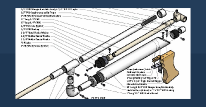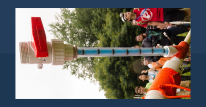
Rifling in Nerf Guns
#1

Posted 06 November 2013 - 08:44 PM
Rifling in nerf guns is NOT intended to impart a spin on the projectile, as the projectile itself is (mostly) stable. This rifling is instead intended to prevent the bullet from bouncing around in the barrel as would be the case in a smoothbore barrel. But performance between the two was mixed
To see for myself, i have acquired two stock Elite Retaliators...
I needed a smoothbore jacket for one, but materials such as brass and PVC are much harder than the barrel of the gun itself, which would create an extra variable or two. I settled on a 2-layer copier paper jacket semipermanently adhered to the barrel, which was close enoguh to the barrel to simulate it's hardness, but far away enough so that the rifling was absent in the new barrel. The light weight of the new barrel ensured no shots would be falsified by an extra variable.
I set up a 7"x7" cardboard target painted in red 25 feet away in a hallway.
I loaded 12 elite darts into the magazine of each rifle and fired all at the target which was exactly at my height.
9 of the rifle barrel darts hit the target, leading to a 75% accuracy total. The darts flew in a fairly straight fashion away from the barrel,with a spread of about 20° from the barrel.
4 of the smoothbore barrel darts hit the target, leading to a 33% accuracy total. The darts tended to sputter out of the barrel, dropping left and right.
I will upload pictures as soon as i can get my camera to start working.
If i can get a high-speed cameraand if i can get a clear barrel, i will test this experiment using a high speed camera to observe the characteristics of the projectiles while in the barrel.
#2

Posted 06 November 2013 - 09:06 PM
#3

Posted 06 November 2013 - 09:25 PM
This rifling is instead intended to prevent the bullet from bouncing around in the barrel as would be the case in a smoothbore barrel.
What makes you think a dart bounces around in the barrel? There's no evidence it does. In fact, the high speed video I've seen suggests the darts don't bounce around in a smoothbore barrel at all.
And how would rifling prevent the dart from bouncing around? If the dart engages rifling grooves then it will also touch the barrel walls in a smoothbore. It won't be "bouncing around" in either case.
I loaded 12 elite darts into the magazine of each rifle and fired all at the target which was exactly at my height.
9 of the rifle barrel darts hit the target, leading to a 75% accuracy total. The darts flew in a fairly straight fashion away from the barrel,with a spread of about 20° from the barrel.
4 of the smoothbore barrel darts hit the target, leading to a 33% accuracy total. The darts tended to sputter out of the barrel, dropping left and right.
Two problems with your tests:
1) They do not appear to have been blinded in any way. For all we know you unconsciously biased the results.
2) You did not do enough tests to rule out the natural variability of the Nerf gun. The probability that you'd get the results you did if we knew definitively that 4 out of 12 darts would hit the target is about 40%. You'd need to shoot about 40 times and get similar results to have statistically significant results. I highlighted that past tests didn't account for this in my blog post on rifling (which you replied to), but you seemed to have missed it. Here's a calculator to help you out.
#4

Posted 06 November 2013 - 10:21 PM
With a real gun, or even a paintball gun, the projectile travels through grooves called rifling. The grooves create spin which help to stabilize the projectile in flight. In an n-strike (elite) blaster the rifling is little plastic ridges that impart little spin and therefore do little to increase stability.
The whole point of using a smooth barrel is that nerf darts of whatever variety expand to the barrel and make a near perfect seal. This is why stefan foam fits in brass, cpvc, polycarbonate, etc.
If you were to make grooves that were actually deep enough to constitute true rifling, you would have a horrible air seal, and the darts would rapidly decelerate due to friction with the barrel.
#5

Posted 06 November 2013 - 10:49 PM
#6

Posted 06 November 2013 - 11:05 PM
Bob o' Bob and MiG? did some tests with rifled barrels made from some dollar store wand-thingys. If they could drop some info about that here, it'd be better than any 2nd-hand account I could give.
These tests are probably what you are referring to. Unfortunately, MiG did not record his results and basically just claimed rifling worked better in terms of accuracy. He did offer some approximate numbers: smoothbore is 65 to 70% accurate, rifled is 95% accurate, and he took 30 shots for each barrel. If those numbers are right, it is indeed a statistically significant result (p = 0.004%). Unfortunately, we can't really be confident that MiG's memory is completely accurate here. I'd trust a table of recorded results, not just someone saying after the tests "hmm... I think 65% of the darts hit." And the tests were not blinded, so that's another reason to doubt the result.
Honestly, I don't know why people who claim this works can't just do the simple things I suggest that'll ensure they have valid tests. I've been saying the same things for years now and nothing has changed.
#7

Posted 07 November 2013 - 12:01 AM
And the tests were conducted by a Canadian, so that's another reason to doubt the result.
I fixed that for you.
[15:51] <+Rhadamanthys> titties
[15:51] <+jakejagan> titties
[15:51] <+Lucian> boobs
[15:51] <+Gears> titties
[15:51] <@Draconis> Titties.
[15:52] <+Noodle> why is this so hard?
#8

Posted 07 November 2013 - 12:25 AM
#9

Posted 07 November 2013 - 01:41 AM
What about 3dbbq and his fishing line rifling? I haven't tried it but it seems like it would work well with lighter darts.
The issue is not with finding effective means of beginning dart rotation. That part has been demonstrated in a few different methods with varying ease. The issue is that micro darts do not have enough mass at their outside diameter to maintain their spin versus friction with the air. In fact, we tend to take great pains to centralize the mass along the axis, because that seems to help accuracy in our smooth barrels. Interestingly, Slug style darts would be the best candidates for spin stabilization because of the washer weights. That said, it still doesn't help.
[15:51] <+Rhadamanthys> titties
[15:51] <+jakejagan> titties
[15:51] <+Lucian> boobs
[15:51] <+Gears> titties
[15:51] <@Draconis> Titties.
[15:52] <+Noodle> why is this so hard?
#10

Posted 07 November 2013 - 01:05 PM
Using my 3d printer I made an octagonal press to form 17/32" brass tubing into a polygonal shape. It imparted spin in the dart and increased accuracy. However the increased friction required more air pressure behind the dart, and that along with the increased friction resulted in streamline darts peeling like an onion after only a few shots, or if any wear or imperfections were present in the dart. Also the polygonal press was very difficult to use precisely. After ruining a couple dozen darts in this manner I halted further work.
Currently I'm testing a flywheel-based approach to rifling, by 3d printing a new motor housing with angled flywheels to impart a spin on the dart. Initial efforts with 2 flywheels showed some promise, but the dart had a high chance to became unstable due to differing levels of contact with the flywheels if it entered at any position other that directly centered perpendicularly between the flywheels. Straight flywheels would not demonstrate any such instability because the contact point with the dart is a line perpendicular to the path of dart travel. With angled flywheels, the contact point is also angled, so if the dart is off to one side, it gets more contact with one wheel vs the other.
So I added a third flywheel, and angled the 3 of them at 120 degrees around the path the dart would follow. This should act to center the dart such that it receives the correct amount of force from each flywheel. Initial tests with this mechanism at a 30 degree angle of rifling caused severe spin in the dart, to the point of fishtailing uselessly. a little quick real-world math showed that a .50 BMG round with 1 in 15" twist rate has approximately 6 degrees of rifling angle, so I redesigned the printed flywheel housing to use a much shallower angle on the flywheels.
Expect a full writeup when I have finished removing support material from the printed part and tested it.
#11
 Guest_Just Some Bob_*
Guest_Just Some Bob_*
Posted 07 November 2013 - 05:03 PM
I fixed that for you.And the tests were conducted by a Canadian, so that's another reason to doubt the result.
What is all this with people thinking I'm Canadian?
First on FB and now here, too?
NO. I've been there a couple of times and it's cool.
Cold, even. And I hate California's mild Winters enough already.
Though it is clear some of the nerfers there put many of those here to shame.
Also there is a small but significant difference between
"spin has never been shown to help foam darts"
and
"spin has been shown to never help foam darts."
The former is true. The latter is stupid.
Edited by Just Some Bob, 07 November 2013 - 05:11 PM.
#12
 Guest_TheSilverhead_*
Guest_TheSilverhead_*
Posted 07 November 2013 - 06:29 PM
Also, your 'smooth bore jacket' was printer paper. Paper is irregular, able to deform, and high-friction. If you are comparing Nerf-style rifled barrels to Nerf-style fluted, it would be a good comparison. However, the rifled Nerf barrels very rarely make contact with the dart. They are much larger ID than an 'actual' (Read: sealing) barrel. They are NOT intended to aid in flight.
Fluted v Rifled, Nerf brand: Valid
Sealed v Sealed rifled: valid
Rifled Nerf v paper: invalid.
An admirable intent, taken down by lack of proper experimental procedure.
Edited by TheSilverhead, 07 November 2013 - 06:30 PM.
#13

Posted 07 November 2013 - 07:28 PM
Currently I'm testing a flywheel-based approach to rifling, by 3d printing a new motor housing with angled flywheels to impart a spin on the dart.
Sounds like a good approach. I just found out that someone took a similar approach before. I haven't examined their data yet, but their tests seem to be the most comprehensive yet. Their high speed video is very impressive.
What is all this with people thinking I'm Canadian?
I don't think Draconis meant to imply that you're Canadian, rather, that MiG is.
#14

Posted 20 June 2016 - 06:06 PM
I've used my friend's modified nerf stryfe, which has the plastic rifling groves in the barrel. There were some noticeable affects on the darts, like the fact that they sometimes spiraled in flight and sometimes curved in similar directions. My theory is that the rifling, though not affecting range or accuracy, is sometimes causing the Magnus effect on the darts. Idk if this is possible, but this is what I think.
Necro
Edited by Langley, 21 June 2016 - 12:55 AM.
1 user(s) are reading this topic
0 members, 1 guests, 0 anonymous users


 This topic is locked
This topic is locked












